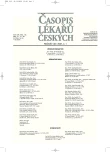Incidence of Hiatal Hernias in the Current Endoscopic Praxis
Authors:
J. Ténaiová; L. Tůma; K. Hrubant; R. Brůha; T. Švestka; A. Novotný; J. Petrtýl; V. Jirásek; P. Urbánek; K. Lukáš
Authors‘ workplace:
IV. interní klinika 1. LF UK a VFN – Gastroenterologické centrum, Praha
Published in:
Čas. Lék. čes. 2007; 146: 74-76
Category:
Original Article
Overview
Background.
Hiatal hernia represents penetration of the oral part of stomach together with the distal part of oesophagus via oesophageal hiatus into the thoracic cavity. On the basis of endoscopic examination hiatal hernia is defined as circular pull out of the gastric mucosa longer then 2 cm from the diaphragm to Z line, measured at the end of examination during removing the endoscope. Hiatal hernia is usually an acquired state which can worsen oesophagitis by holding refluxate and thus by prolonging the duration of purgation.
Methods and Results.
Endoscopic and radiological studies show that 50 to 94 % of patients with gastroesophageal reflux disease have an axial hiatal hernia while in control persons the incidence fluctuates between 13 % and 59 %. Hiatal hernia is a frequent finding during upper gastrointestinal endoscopy. Hernia can contribute to the development of reflux into the proximal oesophagus. A cohort of one thousand patients (18 to 94 years) who underwent upper gastrointestinal endoscopy was analysed retrospectively. Endoscopy was performed between January and June 2005 at the Endoscopic center of the 4th Medical Department of the University Hospital in Prague.
Conclusions.
Presented study has shown that in patients who underwent endoscopy, hiatal hernia occurs in 16.6%, more frequently in men (53.6%). The most common type is an axial hiatal hernia with incidence of 94.58%. In 50% of patients with hiatal hernia the reflux oesophagitis of various degrees was diagnosed.
Key words:
hiatal hernia, reflux oesophagitis, gastroesophageal reflux disease.
Labels
Addictology Allergology and clinical immunology Angiology Audiology Clinical biochemistry Dermatology & STDs Paediatric gastroenterology Paediatric surgery Paediatric cardiology Paediatric neurology Paediatric ENT Paediatric psychiatry Paediatric rheumatology Diabetology Pharmacy Vascular surgery Pain management Dental HygienistArticle was published in
Journal of Czech Physicians

Most read in this issue
- Lower Dyspeptic Syndrome Recommended Diagnostic and Therapeutic Practice for General Practitioners 2006
- HIV/AIDS and Pathology in Blood Count
- Incidence of Hiatal Hernias in the Current Endoscopic Praxis
- Postoperative Pulmonary Thromboembolism and Nosocomial Pneumonias: Differential Diagnosis
